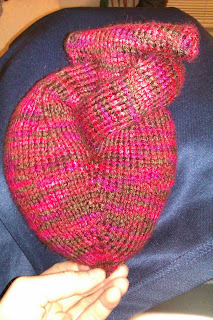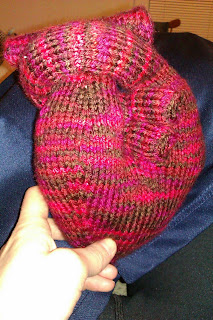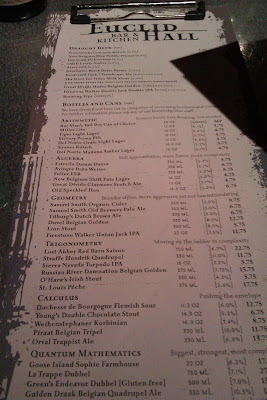There's a park about two towns away from me. I run there pretty much every weekend I'm in town, and when I'm training for anything, it's usually where I do my long runs.
However, after two weeks in Australia, and confounding factors for several weekends on either end of the trip, I haven't been to Lake of the Woods in easily six weeks. It feels like fall just happened there. Sections of the prairie have been mowed down. The birds, which were looking so bright and spiffy during spring and summer when they were eager to impress the ladies, are a little dreary and starting to pack on their winter weight.
Other things are brighter, the milkweed is starting to seed, and there's plants covered with milkweed bugs, from squishy early instars of their life, up to full grown bugs. Some of the pods have split open, and the perfect fish scale patterns of their seeds are showing, or the silk is leaking out of the pods, begging to be touched.
Some stretches of grass were swarmed with grasshoppers. As I ran, I flushed dozens out with every step, flying in all directions and sometimes crashing into me as I went.
It was the most sensory hour of my recent life. Even though I work with things in the nanoscale every day, it felt like a totally different flavor of detail to experience the world in. It was like seeing the park for the first time, but still knowing my way well enough to not worry where I was going.
14 September 2013
06 July 2013
Entrepreneurial approaches to research
I listened to The Lean Startup a while back. I never finished it, but I got far enough to listen to the section on small batch testing. The key concept is that, although it seems counter-intuitive, it's better to move a product all the way through processing rather than moving an entire batch through each individual stage.
I had a frustrating encounter that showed the advantage of this methodology when doing a set of measurements on my latest samples. I recently built an automated testing setup that reduces testing time from a day to several minutes, and provides much higher resolution in the outputs.
It was great. I could do measurements so fast, it was easier to stay in the lab, and then post-process all the data later. In that post-processing, I found some element in the setup wasn't quite aligned, and the data was coming out hinky.
Had I tested and processed each device in series, it would have been obvious within one or two sets of measurements that all was not well, and the dozens of other data sets wouldn't have been wasted. An interesting crossover from a most irksome experience.
I had a frustrating encounter that showed the advantage of this methodology when doing a set of measurements on my latest samples. I recently built an automated testing setup that reduces testing time from a day to several minutes, and provides much higher resolution in the outputs.
It was great. I could do measurements so fast, it was easier to stay in the lab, and then post-process all the data later. In that post-processing, I found some element in the setup wasn't quite aligned, and the data was coming out hinky.
Had I tested and processed each device in series, it would have been obvious within one or two sets of measurements that all was not well, and the dozens of other data sets wouldn't have been wasted. An interesting crossover from a most irksome experience.
29 April 2013
Paper cranes reach the final frontier
Last week Robert J. Lang gave a talk for the computer science department at my university. He has a Ted Talk that presented a very accessible version of his talk to a lay audience, versus the emphasis on algorithm development and its applications to origami that he shared with us on Wednesday.
I've always preferred modular origami and tessellations I found the symmetry and elegance much more immediate, and I loved seeing how repeating units could be built up:
I haven't done much origami in years, except the occasional piece as a gift or decoration for someone. However, seeing the interface between algorithm, art, and engineering that Lang presented (like the up and coming Eyeglass Telescope, or Miura's folding solar panel for Japanese satellite) refreshed my interest. I need to see if I still have paper around...
16 April 2013
What can a student say to Congress about engineering education?
One of my projects over the last several months has been organizing a small delegation of undergraduate students from the university IEEE section to attend the Congressional Visits Day in Washington, DC. CVD is an opportunity for technical professionals to speak to their representatives about the importance of funding education and research in science, engineering and technology fields.
I attended a couple years ago, and I was struck that the bulk of participants were men, either in senior positions in their careers or retired. I think that's a strong demographic to speak on the need for developing engineers and technical capability, but I think it's important for students, actively engaged in their engineering education, to speak up about their experiences. The first hand perspective of someone going through an engineering curriculum offers an insight into what students are experiencing now, rather than a rehash of more, shall we say, historic time frames.
Another reason I think taking the students is to make sure they're exposed to the realities outside their field. In the 112th Congressional Class, there are six engineers and three other scientists out of all the representatives on the Hill, and they're all in the House. That's the same number of accountants, and less than a third of the lawyers. (Stats here.) Without no science background, there's a tremendous amount of information that's easy to glaze over and misunderstand. As engineers, we have a responsibility to look at the factors that feed our technical capacity and recognize the impact that decisions for the short term will have years down the line. We need to make the technological contributions accessible and show the impact clearly, in terms of jobs, money and the metrics that our representatives are interested in.
IEEE has some great resources, and I'm pleased that the students I took did so well. However, the budget changes every year, and things only seem to be getting more expensive. It's critical to remember that this isn't a one-shot effort.
Another reason I think taking the students is to make sure they're exposed to the realities outside their field. In the 112th Congressional Class, there are six engineers and three other scientists out of all the representatives on the Hill, and they're all in the House. That's the same number of accountants, and less than a third of the lawyers. (Stats here.) Without no science background, there's a tremendous amount of information that's easy to glaze over and misunderstand. As engineers, we have a responsibility to look at the factors that feed our technical capacity and recognize the impact that decisions for the short term will have years down the line. We need to make the technological contributions accessible and show the impact clearly, in terms of jobs, money and the metrics that our representatives are interested in.
IEEE has some great resources, and I'm pleased that the students I took did so well. However, the budget changes every year, and things only seem to be getting more expensive. It's critical to remember that this isn't a one-shot effort.
05 April 2013
Firefly butts for better plasma screens...
As I've been continuously aggregating prior art and other background information for my research, I've really enjoyed tracking one specific thread on biomimicry and bioinspiration. A couple of my favorites:
Fish cloaking - Some silver scaled fish have crystals inside their scales which affect how light reflects off their bodies, making them much harder for predators to see.
Firefly lanterns - The pattern of a firefly "lantern" (the apparently correct name for glowing insectoid hindquarters) couples light out very effectively, and might make LEDs and displays more efficient.
Butterfly scales - More well known...the scales of butterfly wings are capable of incredible color mixing.
Fish cloaking - Some silver scaled fish have crystals inside their scales which affect how light reflects off their bodies, making them much harder for predators to see.
Firefly lanterns - The pattern of a firefly "lantern" (the apparently correct name for glowing insectoid hindquarters) couples light out very effectively, and might make LEDs and displays more efficient.
Butterfly scales - More well known...the scales of butterfly wings are capable of incredible color mixing.
14 February 2013
Valentine's Day Heart
I'm not much of a Valentine's Day person, but I gave it a shot this year, knitting the stylized anatomical heart by Kristen Ledgett at Knitty.
It took about a day, while I was reading/reviewing papers to make my qualifying exam presentation, and I am rather pleased with how it turned out.
I wish the valves were a little more visible on this picture, but the variegated yarn makes for poor contrast.
It took about a day, while I was reading/reviewing papers to make my qualifying exam presentation, and I am rather pleased with how it turned out.
31 January 2013
Evolution of Language: The Good, The Bad and The Annoying
As a relatively loyal Linux user, I had never heard the term "Apple Ecosystem" until just a few weeks ago. Recently, though, it's been coming up constantly. Every time I hear it, I feel like Inigo Montoya from The Princess Bride, "You keep using that word. I do not think it means what you think it means."
Generally, I enjoy the fluidity and adaptability of language, American English in particular. I didn't realize how amazing this is until I was in Mallorca for a conference. We had a local tour guide for a day, and someone recommended that she "google" something. She commented how much she liked how we could make new words as needed in English, and that she didn't think it was as common in Spanish.
However, I don't think absconding with a word and diluting the incredible complexity associated with it, as in the case of the new 'ecosystem', has any additive value to the language. And it drives me crazy.
10 January 2013
Nerdy Delicious
It was an excellent find.
01 January 2013
Reflect from a distance
During a summer of undergrad research, the student who was training me left for three weeks to go to Japan. Our project was not in its most successful phase and the industry PI had been increasingly merciless in hounding this student. Upon returning from Japan, he seemed unruffled by the external hazing we were receiving, a dramatic shift from his extreme distress regarding the PI and project even as he left the lab to drive to the airport.
I attributed it to the relaxation of a vacation, but he told me that whenever you have to make important decisions or solve hard problems, you need to get away from it for a little while. You can see things from a different perspective, let your mind work in the background, and be away from the immediate environmental pressures associated with whatever you're trying to sort out.
I try to take a least one big trip a year, just to invite a little perspective shift in. I particularly like it around the new year, where I can look at bigger pictures goals without being distracted by the small things that become clutter in your life at home.
Subscribe to:
Posts (Atom)





